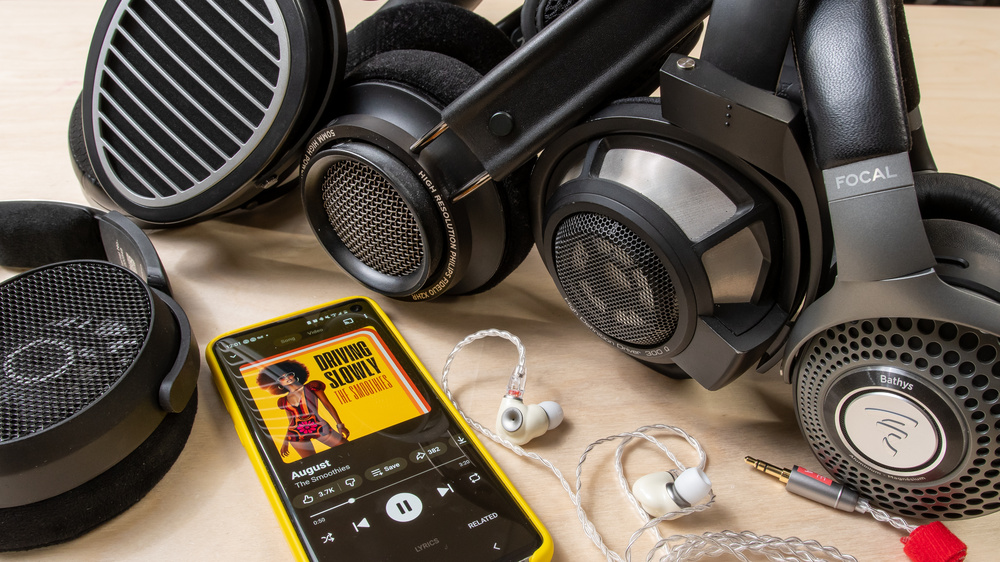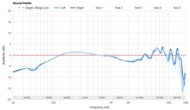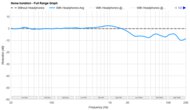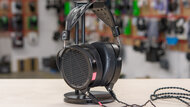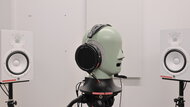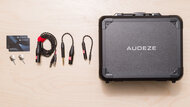The choices can be overwhelming if you're looking for headphones that are great for music. Depending on what kind of music you like, some headphones are better suited than others. Those listening to more instrumental or vocal-centric content, like jazz or folk, may prefer a more balanced sound with a wide, immersive soundstage. On the other hand, fans of EDM, hip-hop, and R&B may like their bass to give their favorite tracks extra thump and kick.
We've tested over 845 pairs of headphones, and below are our recommendations for the best music headphones based on sound profile, features, and price range. For more picks, check out our articles on the best audiophile headphones, the best studio headphones, and the best wired headphones.
Quick Look





-
Best Headphones For Music
 Audio Reproduction Accuracy8.5Frequency Response Consistency8.4Peaks/Dips8.0See all our test resultsStereo Mismatch8.4
Audio Reproduction Accuracy8.5Frequency Response Consistency8.4Peaks/Dips8.0See all our test resultsStereo Mismatch8.4The Sennheiser HD 800 S are the best headphones for music we've tested. They create an incredibly spacious and wholly immersive listening experience, making your music sound a bit like it's coming from two speakers in a room. If you're looking for top-tier quality and intend to spare no expense, these premium headphones are among the best open-back headphones you can buy. Their flat sound profile will also please audiophiles, as it makes vocals and lead instruments sound clear, present, detailed, and airy.
However, it's worth noting they're very expensive. That high price point can put them well out of reach for most people, especially considering the added cost of a dedicated amp. They're very well-built, with a sturdy-feeling design made of high-grade plastic reinforced by a metal frame and a braided detachable audio cable. Their spacious, breathable, and well-padded ear cups will also ensure you don't experience any discomfort, even during long listening sessions. Unfortunately, they do lack a little bass. If you're a bass-head, you may be better served by our next pick, the HiFiMan Arya Stealth Magnet Version, or the Audeze LCD-X, which we discuss further down the page.
-
Best Upper Mid-Range Headphones For Music
 Audio Reproduction Accuracy7.9Frequency Response Consistency7.6Peaks/Dips7.6See all our test resultsStereo Mismatch7.1
Audio Reproduction Accuracy7.9Frequency Response Consistency7.6Peaks/Dips7.6See all our test resultsStereo Mismatch7.1There are two main downsides to the Sennheiser HD 800 S: they're very expensive, and they lack low-bass thump. Into the ring step the HiFiMan Arya Stealth Magnet Version. If you're a die-hard EDM fan who simply must feel the rumble and thump of a kick drum or simply an audiophile willing to spend money but not an entire month's salary on a pair of headphones, the HiFiMan are a great alternative to Sennheiser's flagships. These cans offer an exceptional amount of bass for open backs, so basslines feel full and enveloping. Their impressively flat mid-range ensures voices and instruments alike are reproduced with detail and clarity. But if you're a fan of hearing all the little details in mixes, it's their treble that might make these cans stand out the most. It's remarkably close to our target, making these a good choice for editing work.
But the HiFiMan aren't without their downsides. They're bulkier and less stable than the Sennheiser, making them less suitable for long listening or mixing sessions. And their build quality feels a notch below their expensive rivals, but that's what we'd expect since the HiFiMan are less than half the price of the Sennheiser. But the increased bass and lower price may just make those tradeoffs worth bearing.
-
Best Mid-Range Headphones For Music
 Audio Reproduction Accuracy8.3Frequency Response Consistency8.3Peaks/Dips8.2See all our test resultsStereo Mismatch8.0
Audio Reproduction Accuracy8.3Frequency Response Consistency8.3Peaks/Dips8.2See all our test resultsStereo Mismatch8.0An excellent music listening experience doesn't necessitate a top-dollar investment; many sub-$500 headphones offer a high-quality audiophile experience with minimal sacrifices. Our pick we've tested at this price point are the Sennheiser HD 490 PRO. Like the Sennheiser HD 800 S, they use dynamic drivers, delivering a balanced sound that suits everything from techno to jazz. However, the 490 PRO's bass response is actually closer to the HiFiMan Arya Stealth Magnet Version's. For open-backs, these cans bring plenty of thump and punch to your mixes, making them a great choice for more modern, electronics-heavy genres. Their balanced mid-range still ensures vocals and instruments are clearly and accurately represented, so there's something here for every music lover.
While they're less taxing on your wallet than the HiFiMan, the HD 490 PRO have some tradeoffs. First, their audio doesn't sound as immersive and spacious as their more premium cousin. Second, their treble range isn't as bright and clear as the HiFiMan. You may enjoy that sound, but it makes them a bit less suited to detailed editing work than the more expensive pair. Finally, the 490 PRO feel a touch less sturdy than the HiFiMan, with flimsier plastic yokes, which aren't as robust as the rest of their construction. But they're comfortable and lightweight, making them a great choice for extended listening sessions. To top it all off, these headphones come with a second pair of swappable ear cups, which change their sound signature if you want to mix things up.
-
Best Lower Mid-Range Headphones For Music
 Audio Reproduction Accuracy8.0Frequency Response Consistency8.3Peaks/Dips7.5See all our test resultsStereo Mismatch8.6
Audio Reproduction Accuracy8.0Frequency Response Consistency8.3Peaks/Dips7.5See all our test resultsStereo Mismatch8.6Looking for great sound and great value at the same time? Check out the Sennheiser HD 560S. While these cans can't match the Sennheiser HD 490 PRO for bass output, they have even flatter mids and treble than their more expensive sibling. That makes the 560S one of the best value deals on the market: you're getting Sennheiser's accurate, detailed sound in a fairly affordable package. Voices sound as the mix engineer intended, and instruments are reproduced accurately. Of course, as we already alluded to, techno heads may wish for more bass, but you can always experiment with adding bass via EQ or consider a pair of closed-backs like the FIIO FT1. But the FIIO's sound changes quite a bit based on your anatomy or if you wear glasses.
As you might expect with cans that retail for around $200, these can't match their more expensive pairs on this list for build quality. They feel a little cheaper than the 490 PRO, with flimsy yokes that you'll want to be careful with. They also don't fold flat like the 490 PRO, making these a bit more annoying to pack away. Still, they're lightweight and comfortable, which we've come to expect from Sennheiser, so if you're looking for excellent value audiophile cans, these are a great place to begin.
-
Best Budget Headphones For Music
 Audio Reproduction Accuracy7.6Frequency Response Consistency7.7Peaks/Dips7.7See all our test resultsStereo Mismatch7.6
Audio Reproduction Accuracy7.6Frequency Response Consistency7.7Peaks/Dips7.7See all our test resultsStereo Mismatch7.6Looking for the best music headphones on a budget? Look no further than the Philips SHP9500. These entry-level audiophile headphones have an open-back design for a more spacious listening experience. They're decently well-built, but they're not as stable on the head as the Sennheiser HD 560S, so headbangers take care! The fabric that covers their earpads can also easily tear, and their swiveling ear cups aren't the sturdiest, either.
Like the more expensive Sennheiser pair, they have a generally flat sound, making them well-suited for genres like classical and folk that rely on accurately reproducing vocals and lead instruments. Whatever you're listening to, their detailed mids and treble provide plenty of clarity. That said, their treble can be a bit piercing at times, unlike the more controlled Sennheiser. But their main downside is a lack of low bass, which is even more subdued than the bass-shy Sennheiser pair. If a thumpy low-end is important to you, the Superlux HD 681 are semi-open-backs that more closely resemble the bass response of the Sennheiser cans, but at a budget price point. Unfortunately, their treble response is piercing, and they have a disappointing build quality.
-
Best Warm Sound Profile Headphones
 Audio Reproduction Accuracy7.4Frequency Response Consistency7.9Peaks/Dips7.9See all our test resultsStereo Mismatch8.7
Audio Reproduction Accuracy7.4Frequency Response Consistency7.9Peaks/Dips7.9See all our test resultsStereo Mismatch8.7The LCD-X is a favorite among mix engineers for a reason: these cans offer impressive punch for a pair of open-backs, along with an accurate mid-range that reproduces voices and instruments alike with accuracy and clarity. When it comes to build quality and comfort, there's little to choose between these and other premium headphones like the Sennheiser HD 800 S. It's worth noting the Audeze are a fair bit heavier than the Sennheiser, which may be important if you enjoy very long listening sessions, but in our tests, we found them to be about as comfortable as each other.
There are two main reasons to consider buying these cans over the Sennheiser. First, while still expensive, the Audeze are a little cheaper, and they come with a nice hard carrying case, too. Second, even though you can customize most headphones via EQ, fans of a smoother, warmer sound may appreciate that these come with that tuning right out of the box. Some find the Sennheiser's ever-so-slightly bright treble a little fatiguing over long periods, and prefer the Audeze's slightly subdued response in that region. That warmer tone is something of an Audeze signature: you can hear a different take on that in-house sound in their Audeze MM-500. The MM-500, made in collaboration with famous mix engineer Manny Marroquin, have more accurate high-mids and low-treble than the LCD-X, which renders the upper harmonics in vocals with more presence, but they're also a fair bit more expensive than the LCD-X, and aren't quite as punchy in the low-end. It's worth mentioning that neither Audeze pair can match the Sennheiser's immersive, speaker-like sound. For that, Sennheiser's flagship audiophile headphones remain unmatched.
-
Best Casual-Use Headphones For Music
 Audio Reproduction Accuracy8.0Frequency Response Consistency7.9Peaks/Dips7.5See all our test resultsStereo Mismatch8.6
Audio Reproduction Accuracy8.0Frequency Response Consistency7.9Peaks/Dips7.5See all our test resultsStereo Mismatch8.6If you care about your music but don't want to sacrifice features like noise cancelling and portability, consider the Focal Bathys Wireless. They're Bluetooth headphones, which makes them easier to use when you're out and about. They also come with everyday essentials like a mic and a great active noise cancelling (ANC) feature that can block out noise like ambient chit-chat or rumbling engines. Their closed-back design doesn't leak your music, but they don't reproduce audio that sounds as immersive and wide as open-backed headphones like the Sennheiser HD 800 S. That said, unlike the analog-only headphones on this list, these cans come with support for wired USB-C audio along with analog and Bluetooth, making them very versatile.
They offer a balanced sound that suits every kind of music. They actually deliver much more low and mid-bass than the open-back Sennheiser, which makes them well-suited for genres like EDM and hip-hop. That said, their response in the upper mid-range and low-treble is a little uneven, so voices can sound just a touch harsh or dull depending on the pitch of the singer. Still, you can use their companion app's graphic EQ and presets to create a sound profile that suits your preferences. They're also very comfortable and have a 30-hour battery life, so they'll last through several full workdays without needing additional power.
While their impressive ANC is helpful for listening in noisy environments, it can't match the top-tier ANC of the Sony WH-1000XM6. If noise isolation is a top priority, the Sony are a good alternative to the Focal, although their sound can change depending on your head size and if you wear glasses, whereas the Focal are more consistent.
-
Best In-Ear Headphones For Music
 Audio Reproduction Accuracy7.9Frequency Response Consistency8.0Peaks/Dips7.7See all our test resultsStereo Mismatch8.8
Audio Reproduction Accuracy7.9Frequency Response Consistency8.0Peaks/Dips7.7See all our test resultsStereo Mismatch8.8If you prefer an in-ear fit, consider the Meze ALBA. These wired in-ear monitors (IEMs) are a lightweight and portable alternative to bulkier over-ear audiophile headphones like the Sennheiser HD 560S. They offer a remarkably comfortable and secure fit, with over-ear cable routing that helps keep them stable even if you move around. The detachable cables are also a practical bonus, as you can easily replace them if they get damaged.
Their sound profile is balanced and detailed, making them a great match for a wide range of musical genres. Vocals and instruments are reproduced with accuracy and detail. Like most in-ears, though, they produce a more intimate soundstage than over-ears, so your audio lacks depth and feels like it's coming from inside your head. Still, this design also helps them block out more ambient noise than closed-back over-ears like the FIIO FT1.
If the Meze are outside your budget, the TRUTHEAR x Crinacle ZERO: RED are a strong lower-cost alternative. They also feature over-ear cable routing and a similarly balanced sound, but with a twist: if you prefer a bassier sound, you can use the included 10-ohm adapter to boost the bass. That said, they don't include the ALBA's USB-C adapter and aren't quite as comfortable or well-built, making them slightly less versatile overall.
If you're still looking for more in-ear headphones, check out our best-sounding wireless earbuds article!
Notable Mentions
-
HiFiMan Edition XS:
The HiFiMan Edition XS put out more bass than the Sennheiser HD 560S, which fans of modern electronic genres may prefer. But the HiFiMan have a slightly uncontrolled treble that can sound a touch piercing at times. They're also not quite as comfortable as the Sennheiser pair.
See our review -
Sennheiser HD 6XX:
The Sennheiser HD 6XX have a smoother treble than the Sennheiser HD 560S, which some listeners may appreciate. However, the HD 6XX can't quite match the HD 560S for bass output and aren't quite as comfortable as our pick.
See our review -
Audeze MM-100:
The Audeze MM-100 are wired, planar magnetic open-back headphones designed for professional audio mixing applications. If you're a fan of a recessed, smoother treble, these make an interesting alternative to the Sennheiser HD 490 PRO. But the Sennheiser's sound is more versatile, and they're more comfortable for long listening periods.
See our review -
Beyerdynamic DT 990 PRO:
The Beyerdynamic DT 990 PRO are wired audiophile headphones. They're better built than the Sennheiser HD 560S and have a more stable fit, but many will find their treble range too piercing. They're also not as comfortable as the Sennheiser, which are better suited to long listening sessions.
See our review -
MOONDROP Blessing 3:
The MOONDROP Blessing 3 are a worthy alternative to the Meze ALBA. Their balanced sound signature aligns closely with our target curve, making them a strong choice for all kinds of music genres. However, they come at a higher price than the Meze, lack an analog to USB-C adapter, and aren't quite as comfortable.
See our review
Recent Updates
Nov 03, 2025:
We've revised this article slightly to better serve readers shopping at different price points. The HiFiMan Arya Stealth Magnet Version are our new upper mid-range pick, which means our Sennheiser HD 490 PRO become our mid-range pick. The Sennheiser HD 560S are our new lower mid-range pick. We've also added a new 'Best Warm Sound Profile' pick: the Audeze LCD-X.
Aug 06, 2025:
The Focal Bathys Wireless replace the Sony WH-1000XM4 Wireless as our 'Best Casual-Use Headphones For Music,' with the Sony WH-1000XM6 as an alternative for anyone prioritizing noise isolation. The Meze ALBA are our new 'Best In-Ear Headphones For Music.' That means the MOONDROP Blessing 3 are now a Notable Mention, alongside the newly added Sennheiser HD 6XX. We have also made the FIIO FT1 a closed-back alternative to the Philips Fidelio X2HR and updated the rest of this article to align with changes made in Test Bench 2.0.
Apr 17, 2025:
The Sennheiser HD 560S have been added as an alternative to the HiFiMan Sundara 2020, and the Philips Fidelio X3 were added as an alternative to the Philips Fidelio X2HR due to fluctuating prices and availability. Minor edits to the text were made throughout for clarity.
Jan 14, 2025:
In addition to minor edits for clarity, we've changed our pick for the upper mid-range category from the HiFiMan Edition XS to the Sennheiser HD 490 PRO, as the Sennheiser control their frequency response better. The Focal Bathys are now part of our Notable Mentions as a more audiophile-focused casual pair of headphones.
Sep 30, 2024: The Philips SHP9500 are back in stock, and so they replace the Superlux HD 681 as our budget pick. The Superlux are mentioned in the budget category for fans of bass-heavy music.
All Reviews
Our recommendations above are what we think are currently the best wired headphones for music to buy for most people. We factor in the price (cheaper headphones win over pricier ones if the difference isn't worth it), feedback from our visitors, and availability (no headphones that are difficult to find or almost out of stock everywhere).
If you would like to choose for yourself, here is the list of all our reviews, ranked by their suitability for neutral sound. Be careful not to get caught up in the details. There are no perfect headphones. Personal taste, preference, and where you use the headphones will matter more in your selection.
